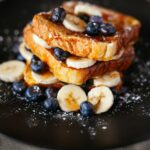How Much Food For Goldfish is a common concern among fish keepers, influencing their health and vitality; FOODS.EDU.VN offers expert guidance on goldfish nutrition, ensuring proper growth and vibrant health. This article delves into the intricacies of feeding goldfish, offering insights into the right quantities, suitable food types, and optimal feeding schedules to keep your aquatic pets thriving.
1. Understanding Goldfish Dietary Needs
Goldfish, being omnivores, enjoy a varied diet. Understanding their digestive system and nutritional requirements is the first step in ensuring they receive the right amount of food. Unlike humans, goldfish lack a stomach; instead, they digest food as it passes through their intestines. They also possess pharyngeal teeth, which help them grind food.
1.1. Omnivorous Nature
Goldfish are opportunistic eaters, meaning they will consume almost anything they come across. However, this doesn’t mean you should feed them just anything. A balanced diet consisting of high-quality foods is essential for their health. Goldfish thrive on a diverse menu that includes:
- Pellets: High-quality sinking pellets designed specifically for goldfish.
- Flakes: While suitable for singletail goldfish, flakes should be used sparingly for fancy goldfish due to the risk of air ingestion.
- Frozen Foods: Bloodworms, brine shrimp, and daphnia offer essential protein and nutrients.
- Vegetables: Blanched broccoli, spinach, courgette, and shelled peas provide vital fiber and vitamins.
- Live Plants: Elodea and other aquatic plants offer a constant source of food and fiber.
1.2. Digestive System
Goldfish have a unique digestive system that processes food as it moves through their intestines. This means they need to eat regularly but in small quantities to avoid overloading their system. The absence of a true stomach necessitates frequent, smaller meals.
1.3. Sifting Behavior
Goldfish are natural sifters, often taking in mouthfuls of gravel and other materials to find food. This behavior is normal, and they are adept at separating edible items from debris. Observing your goldfish sifting through the substrate is a sign of natural foraging behavior.
2. Tailoring Feeding to Goldfish Varieties
The amount and type of food should be adjusted based on whether you have common/singletail goldfish or fancy goldfish.
2.1. Common/Singletail Goldfish
These goldfish usually have more robust digestive systems. Their body shape allows their internal organs to develop correctly, enabling them to eat a wider variety of food. Common and singletail goldfish typically:
- Tolerate both floating and sinking foods.
- Can digest flake food without issue.
- Prefer pellets due to their larger size.
2.2. Fancy Goldfish
Fancy goldfish, with their compacted body shapes, may have digestive systems that are more sensitive. Due to their body structure, fancy goldfish are prone to digestive issues. Therefore, special care should be taken to ensure their diet is appropriate for their needs. They often experience:
- Internal organs that are squashed or misshapen.
- Swim bladder issues due to intestinal blockages.
- Difficulty with floating foods that cause air ingestion.
3. Ideal Foods for Fancy Goldfish
Fancy goldfish require a diet that is easy to digest and prevents buoyancy issues.
3.1. Sinking Pellets
Sinking pellets are highly recommended for fancy goldfish. They reduce the likelihood of the fish gulping air while feeding, which can lead to swim bladder problems. High-quality brands like Tetra, Hikari, and Dainichi are popular choices among fancy goldfish keepers.
3.2. Soaking Food
Always soak dry food for a few minutes before feeding. This helps prevent the food from expanding in the fish’s stomach, which can cause indigestion and buoyancy problems. Soaking ensures the food is soft and easy to digest.
3.3. Frozen Foods
Defrosted frozen foods such as bloodworms, brine shrimp, and daphnia are excellent for fancy goldfish. These foods provide essential nutrients and are easy to digest. Rinse the defrosted food in a tea strainer to remove any excess water and impurities.
3.4. Green Vegetables
Blanched vegetables like broccoli, spinach, and courgette, as well as shelled peas, are vital for a balanced diet. These vegetables provide fiber and vitamins that support healthy digestion. Spinach can be offered in a vegetable clip, while broccoli and courgette can be weighed down with a plant weight.
3.5. Algae Wafers
Broken up and well-soaked algae wafers can be a nutritious alternative to pellets. These wafers offer a different texture and nutrient profile that can benefit your goldfish.
3.6. Gel Food
Gel food, such as Repashy Soilent Green, is a convenient option for providing a balanced diet. You can either make your own gel food or purchase pre-made powders that mix with hot water to form a gel.
3.7. Live Plants
Live plants like elodea are not only decorative but also serve as a continuous source of food and fiber. Goldfish enjoy nibbling on these plants, which helps to supplement their diet.
4. Crafting a Goldfish Feeding Schedule
Establishing a consistent feeding schedule is crucial for maintaining the health and well-being of your goldfish. Regular feeding times help regulate their metabolism and prevent overeating.
4.1. Frequency of Feeding
Feed your goldfish twice a day, once in the morning and once in the evening. This provides a steady supply of nutrients without overloading their digestive system.
4.2. Portion Sizes
The amount of food should be carefully monitored. Avoid overfeeding, as this can lead to health problems. A good guideline is to feed them an amount they can consume in about two minutes.
4.3. Varying the Diet
Provide a mix of dried food in the morning and vegetables or frozen food in the evening. This ensures they receive a balanced diet with all the necessary nutrients. Varying their diet keeps them interested and ensures they get a wide range of nutrients.
4.4. Feeding Young Goldfish
Young fish benefit from smaller, more frequent feedings. This supports their rapid growth and development. Ensure young goldfish have access to nutrient-rich foods that promote healthy growth.
4.5. Feeding Adult Goldfish
Adult fish are content with twice-daily feedings. However, always ensure they have access to live plants for snacking between meals. Live plants provide a constant source of fiber and nutrients, keeping them healthy and active.
5. Determining the Right Amount of Food
Knowing how much to feed your goldfish is a delicate balance. Underfeeding can lead to malnutrition, while overfeeding can cause obesity and water quality issues.
5.1. Dispelling Myths
Ignore the suggestion of feeding the same amount of food as the size of your fish’s eye. This is not nearly enough for a goldfish. Goldfish require a substantial amount of food to maintain their health and energy levels.
5.2. Practical Guidelines
Feed as much as they can eat in a couple of minutes. This guideline is often recommended and provides a good starting point for determining the right amount.
5.3. Adjusting Portion Sizes
Experiment with different portion sizes to find what works best for your fish. Don’t be afraid to give them a reasonable amount; a couple of pellets is usually not sufficient. Monitor their eating habits and adjust the portion sizes accordingly.
5.4. Portion Examples
As a rough guide, adult goldfish (around 30cm long) typically need about a teaspoon of pellets, two to three algae wafers, a cube of frozen food, or about four peas per fish per feed. Adjust these amounts based on the size and appetite of your fish.
5.5. Balancing Act
Providing an average portion for each fish in a mixed-size group can help balance out the feeding. The larger fish may get a little more, while the smaller ones get a little less. This ensures that all fish receive adequate nutrition.
5.6. Goldfish Growth Chart
This chart shows a rough idea of the size a healthy goldfish should be at various ages.
| Age | Size (Inches) | Size (cm) |
|---|---|---|
| 1 year | 2-3 | 5-7.5 |
| 2 year | 4-6 | 10-15 |
| 3 year | 6-8 | 15-20 |
| 4 year | 8-10 | 20-25 |
| 5+ year | 10+ | 25+ |

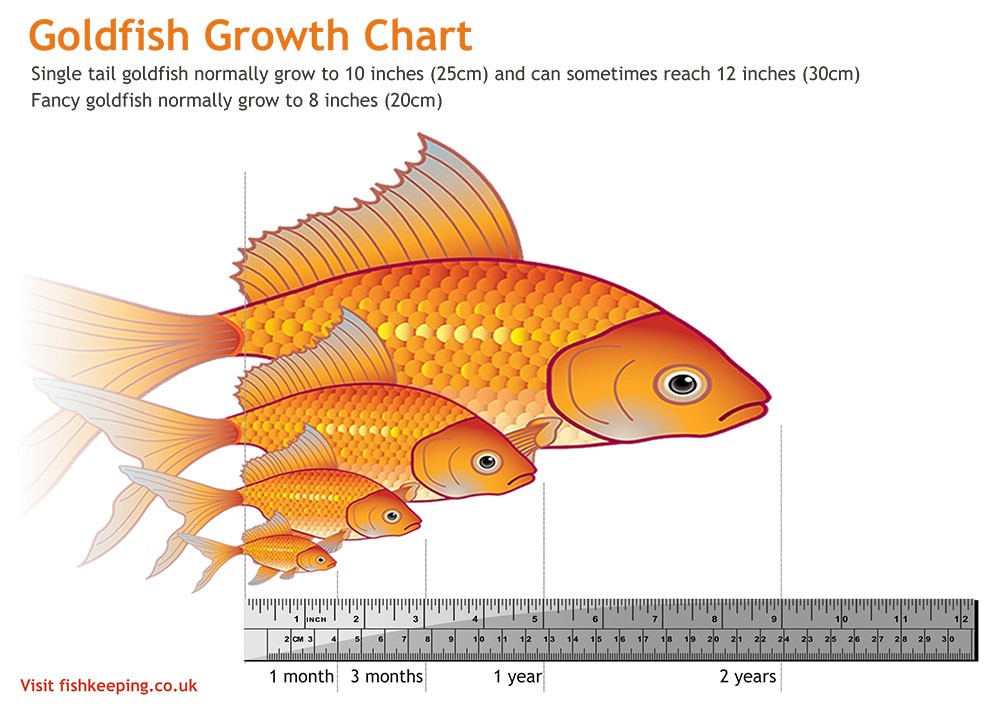
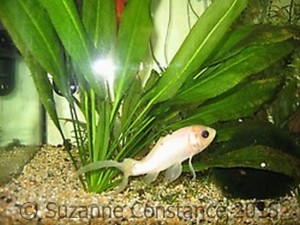
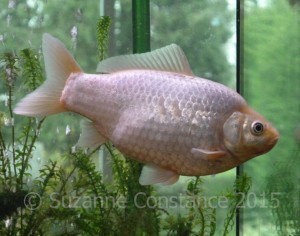
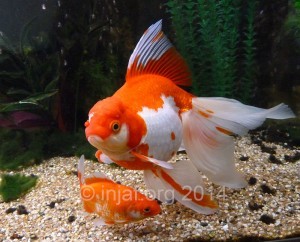
6. Observing Your Goldfish
Regular observation is key to determining whether you are feeding your goldfish the right amount. Watch for signs of underfeeding, overfeeding, and overall health.
6.1. Begging Behavior
Goldfish are notorious beggars. They will often act excited and swim to the front of the tank when they see you, hoping for food. Resist the urge to overfeed them, even if they seem hungry.
6.2. Monitoring Waste
Keep an eye on your fish’s waste. Translucent, empty-looking poos can indicate underfeeding, while excessive waste suggests overfeeding. The color and consistency of their waste can provide valuable insights into their digestive health.
6.3. Assessing Body Condition
Check your fish’s body condition regularly. A skinny goldfish, especially around the belly, is likely underfed. A healthy goldfish should be well-rounded and chunky. Avoid letting your fish become overweight.
7. Addressing Common Feeding Problems
Several issues can arise when feeding goldfish. Knowing how to identify and address these problems can ensure your fish remain healthy.
7.1. Overfeeding
Overfeeding is a common mistake among goldfish keepers. It can lead to obesity, swim bladder problems, and poor water quality. Reduce the amount of food you are giving if you notice your fish are becoming sluggish or overweight.
7.2. Underfeeding
Underfeeding can result in malnutrition and stunted growth. Increase the amount of food if your fish appear skinny or are not growing properly.
7.3. Buoyancy Problems
Buoyancy problems, often caused by air ingestion or digestive issues, can be managed by feeding sinking pellets and soaking food beforehand. Correcting buoyancy issues requires careful attention to diet and feeding habits.
7.4. Water Quality Issues
Poor water quality can result from overfeeding and uneaten food. Regularly test your water and perform water changes to maintain a healthy environment. Regular water changes and proper filtration are essential for maintaining a healthy aquarium.
8. Exploring Additional Dietary Options
While commercial goldfish food provides a balanced diet, supplementing with other foods can enhance their health and well-being.
8.1. Homemade Food
Consider making your own goldfish food using recipes that include vegetables, protein sources, and vitamins. Homemade food can be tailored to your fish’s specific needs and preferences.
8.2. Treats
Offer occasional treats like small pieces of fruit or cooked vegetables. Treats should be given in moderation to avoid disrupting their regular diet.
8.3. Herbs
Incorporate herbs like parsley or dill into their diet for added vitamins and minerals. Herbs can provide additional health benefits and add variety to their diet.
9. Advanced Feeding Techniques
For serious goldfish enthusiasts, advanced feeding techniques can optimize their fish’s health and growth.
9.1. Probiotics
Add probiotics to their diet to promote healthy gut bacteria. Probiotics can improve digestion and nutrient absorption.
9.2. Garlic
Use garlic supplements to boost their immune system and prevent disease. Garlic is known for its immune-boosting properties.
9.3. Spirulina
Include spirulina in their diet for vibrant colors and enhanced health. Spirulina is a nutrient-rich algae that can improve the overall health and appearance of your goldfish.
10. Integrating Seasonal Feeding Adjustments
Adjusting your goldfish’s feeding habits based on the season can further optimize their health.
10.1. Summer Feeding
During warmer months, goldfish are more active and require more food. Increase the frequency and portion sizes to meet their increased energy needs.
10.2. Winter Feeding
In colder months, goldfish become less active and their metabolism slows down. Reduce the amount of food you provide to prevent overfeeding and digestive issues.
10.3. Spring and Autumn Feeding
In the transitional seasons of spring and autumn, gradually adjust their feeding habits to match the changing temperatures and activity levels. This gradual approach ensures they remain healthy and adapt smoothly to the seasonal changes.
11. Frequently Asked Questions About Goldfish Feeding
11.1. How Often Should I Feed My Goldfish?
Feed your goldfish twice a day, once in the morning and once in the evening, providing a consistent supply of nutrients.
11.2. What is the Right Amount of Food to Give?
Feed an amount they can consume in about two minutes, adjusting based on their size and appetite.
11.3. Can I Feed My Goldfish Flake Food?
Flake food is acceptable for common goldfish, but sinking pellets are better for fancy goldfish to avoid air ingestion.
11.4. What Vegetables Can I Feed My Goldfish?
Good options include blanched broccoli, spinach, courgette, and shelled peas.
11.5. Are Frozen Foods Good for Goldfish?
Yes, frozen foods like bloodworms, brine shrimp, and daphnia provide essential nutrients.
11.6. How Do I Know If I Am Overfeeding My Goldfish?
Signs of overfeeding include sluggishness, weight gain, and excessive waste production.
11.7. What Should I Do If My Goldfish Has Buoyancy Problems?
Feed sinking pellets and soak food before feeding to help prevent air ingestion and digestive issues.
11.8. Can Live Plants Help With My Goldfish’s Diet?
Yes, live plants like elodea provide a constant source of food and fiber.
11.9. How Can I Tell If My Goldfish Is Underfed?
Underfed goldfish may appear skinny, especially around the belly, and may not grow properly.
11.10. What Are Some Good Treats for Goldfish?
Occasional treats like small pieces of fruit or cooked vegetables can be given in moderation.
12. FOODS.EDU.VN: Your Partner in Goldfish Care
Feeding your goldfish correctly is vital for their health and happiness. By understanding their dietary needs, tailoring their diet to their specific type, and following a consistent feeding schedule, you can ensure they thrive. For more in-depth information and expert advice, visit FOODS.EDU.VN.
At FOODS.EDU.VN, we understand the challenges in finding reliable and easy-to-follow information about pet care. That’s why we’re dedicated to providing detailed recipes, expert knowledge, and helpful tips to simplify your journey. Whether you’re looking to understand the best ingredients, master cooking techniques, or explore diverse cuisines, our platform offers everything you need.
Ready to dive deeper into the world of culinary arts? Visit foods.edu.vn today and unlock a wealth of gastronomic wisdom. Contact us at 1946 Campus Dr, Hyde Park, NY 12538, United States, or reach out via WhatsApp at +1 845-452-9600. Your next culinary adventure awaits.
